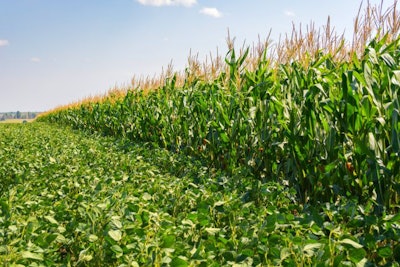
Prices could still see major swings in either direction in coming months, Purdue economists say.
Volatility has become the theme word for the year after corn and soybean prices dropped precipitously in June and into early July, even as questions persist about whether the downward trend will continue.
The U.S. Department of Agriculture (USDA) made minimal changes to projections in its July World Markets and Trade reports. However, in addition to noting that 2.7 million acres of intended soybean plantings were not realized, the reports also slashed anticipations for on-farm prices this fall. Expected prices for corn are down 10 cents to US$6.65 per bushel, and soybeans are down 30 cents to US$14.40 per bushel, according to the USDA.
The cuts appear primarily driven by the recent decline in futures prices for both commodities, according to Jim Mintert, director of the Center for Commercial Agriculture at Purdue University. Prices peaked in early June and then began to decline through the middle of the month before dropping precipitously in early July, USDA’s reports note. As of mid-July, soybean futures were trading for roughly US$13.50, and corn for about US$6, Mintert reported in a Purdue University podcast.
“We’re talking US$1-$1.50 swings, which is huge volatility but seems to be the norm these days,” said Nathan Thompson, an associate professor of agricultural economics at Purdue University.
However, Mintert noted that it’s actually the rapid escalation of futures prices from January 1 through this spring that is truly exceptional. Spring typically brings an increase in prices, Thompson said, though not generally this large. Now that futures have dropped, he said, prices appear to be more in line with what would be expected from seasonal trends.
This year’s outsized spring premium could be related to market risks that never quite materialized, particularly Russia’s invasion of Ukraine, Mintert said. Although the onset of the conflict brought fears of potential shortages of corn, the availability of supplies has exceeded previous expectations, with Russia and Ukraine exporting more than anticipated.
Even so, the risk of significant price swings remains high, Mintert said, particularly in light of increasing drought concerns in the U.S. Corn Belt. Thompson estimated there is a 25% chance corn prices could fall below US$5 per bushel by the end of the year, but also a 25% chance they could exceed US$6.75.
“That’s indicative of the level of risk out there and the difficulty of anticipating where we might head,” Mintert said.
Farmers also continue to experience rapid increases in production costs. Even compared to 6% inflation, farm input costs have increased 17%, according to Michael Langemeier, associate director of Purdue’s Center for Commercial Agriculture. Anhydrous has seen the greatest increase, with prices rising nearly 130% in the past 12 months.










